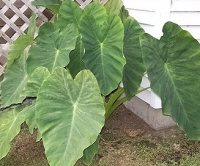Summer Bulbs Grown as Annuals
Summer Bulbs are a category of blooming plants that grow from bulbs or similar structures but are not reliably winter hardy (unlike daffodils, for instance). These flowers are planted as bulbs or roots in the spring, flower in the summer and die in the fall, though they may survive several years if the winters are mild or if their roots are taken up, stored indoors, and replanted the next spring.
Cannas

Cannas are large tropical-looking plants with flamboyant flower heads atop stalks covered with large leaves similar to the banana plant. Cannas grow from swollen storage roots that available in the spring from garden centers or mail order businesses. Varieties grow from four to seven feet in height, and are standouts when planted in island beds by themselves. They are also used in the back of the flower bed. Colors include yellow, red, white, orange, peach. The flowers showy and large growing at the top of the stalks.
Dahlia

Dahlias are one of the most desirable of the garden plants because they bloom all summer, come in nearly any size or color, and they are relatively trouble free.
Dalhias are relatives of the potato and their tuberous roots somewhat resemble the vegetable. Like potatoes, the roots are planted in the spring after frost and will produce more tubers by fall. And like potatoes, the plants cannot survive a killing frost.
Dahlia can be grown from seeds, though the plants take longer to reach blooming size. Varieties can be found that grow from one to four feet in height. Flower sizes vary a great deal as well, from one inch across to over a foot across, (dishplate dahlias). The flowers resemble mums but those too have been bred to satisfy many different tastes.
Elephant Ears

Any gardener who wants to suggest the floral exuberance of the jungle, should try Elephant Ears, a plant whose name and and appearance both evoke the untamed rain forest. The plants are over three feet tall and, of course, have leaves that are the shape and size of a pachyderm's ear.
Elephant Ears grow from a fist sized bulb available from a garden center in the spring. They are planted about four inches deep after the frost season. The plants like half shade and a lot of moisture. Large leaves lose a lot of moisture through transpiration. Soil should be rich with compost or manure added and good drainage.
Each bulb is fairly expensive but the plant covers a large area, at least nine square feet of growing space. The bulbs, or more properly tuberous roots, are also available through mail order or E-bay (See ad below).
Elephant Ears do not survive freezing. The bulbs can be dug up in the fall, along with any new bulbs, and stored in a cool dry place until spring.
Gladiolus
written by joseph cash
Gladiolus have four foot tall flower spikes that are ideal for bouquets. The gaudy blooms grow from a plant starting from a bulb-like structure called a "corm". Gladiolus are native to South Africa and grow best on a sunny site in sandy loam soil with good water drainage. The bulbs can be purchased by the bag in the spring. Many bright colors and multicolor varieties are available.
Mix compost and manure into planting beds in spring to help feed the growing plants. Gladiolus can be planted about two weeks before the last expected spring frost. It will take 70 to 90 days from planting until flowering. For a continual harvest of flower spikes, plant a few corms every two weeks until early summer. Plant corms two to three inches deep, depending on their size, and cover with soil. Space corms eight inches apart groups of six to 15 corms. Once the plants are about 6 inches high, hill up the soil around the base of the plant to help support the stem.
Apply a liquid fertilizer or manure tea five inches away from the stems when the plants are six inches tall. Apply a second application when the flower spikes start to show color. Keep the plants weed-free and mulched with a 2- to 4-inch-thick layer of bark mulch, wood shavings or straw. Keep plants well watered to produce the largest flowers. Tall varieties will probably need staking to prevent the flower spikes from falling over in the wind.
If you're growing gladiolus so you can cut blooms for bouquets, flower spikes should be cut on a slant when the lowest flowers on the stalk begin to show color. When cutting the flower stalk, leave at least four leaves on the plant to feed the corm for next year's blooms.
Gladiolus are not winter hardy , but can sometimes survive mild winters if heavily mulched. In USDA zones seven and eight, mulch gladiolus beds for protection. In USDA zones five and six, except for the hardy gladiolus varieties, dig up the corms for winter storage before the first heavy frost.
Clean the corms, cut the stalk within half an inch of the corm, and let them cure for one to two weeks in a warm, airy location. When dry, remove and discard the old corm as well as any small cormels. Store the large, new corms in plastic mesh bags in a well-ventilated room where temperatures remain from 35 to 50 degrees F.
Gladiolus gets its name from its long narrow leaves that resemble sword blades. The ancient Roman armies used swords called "gladius" (from which gladiator is derived).
|


